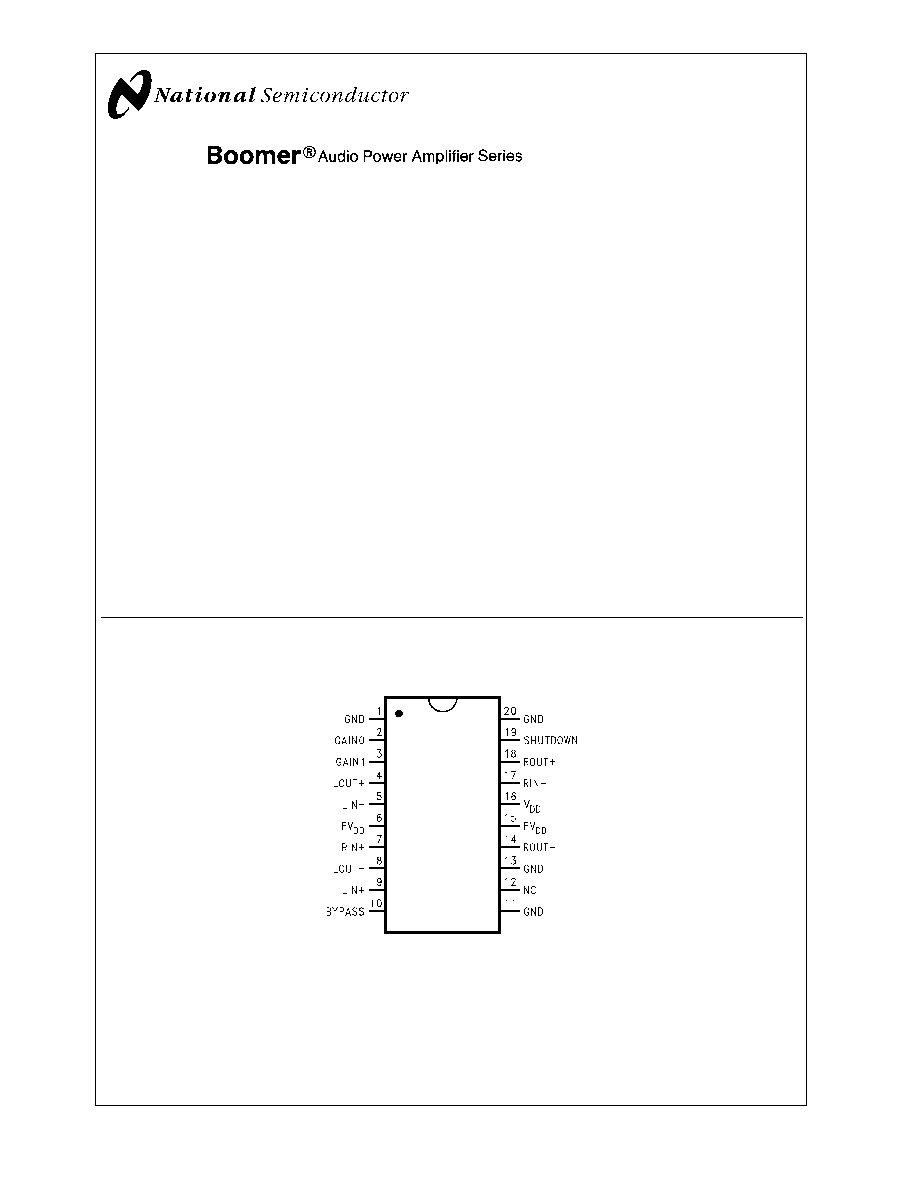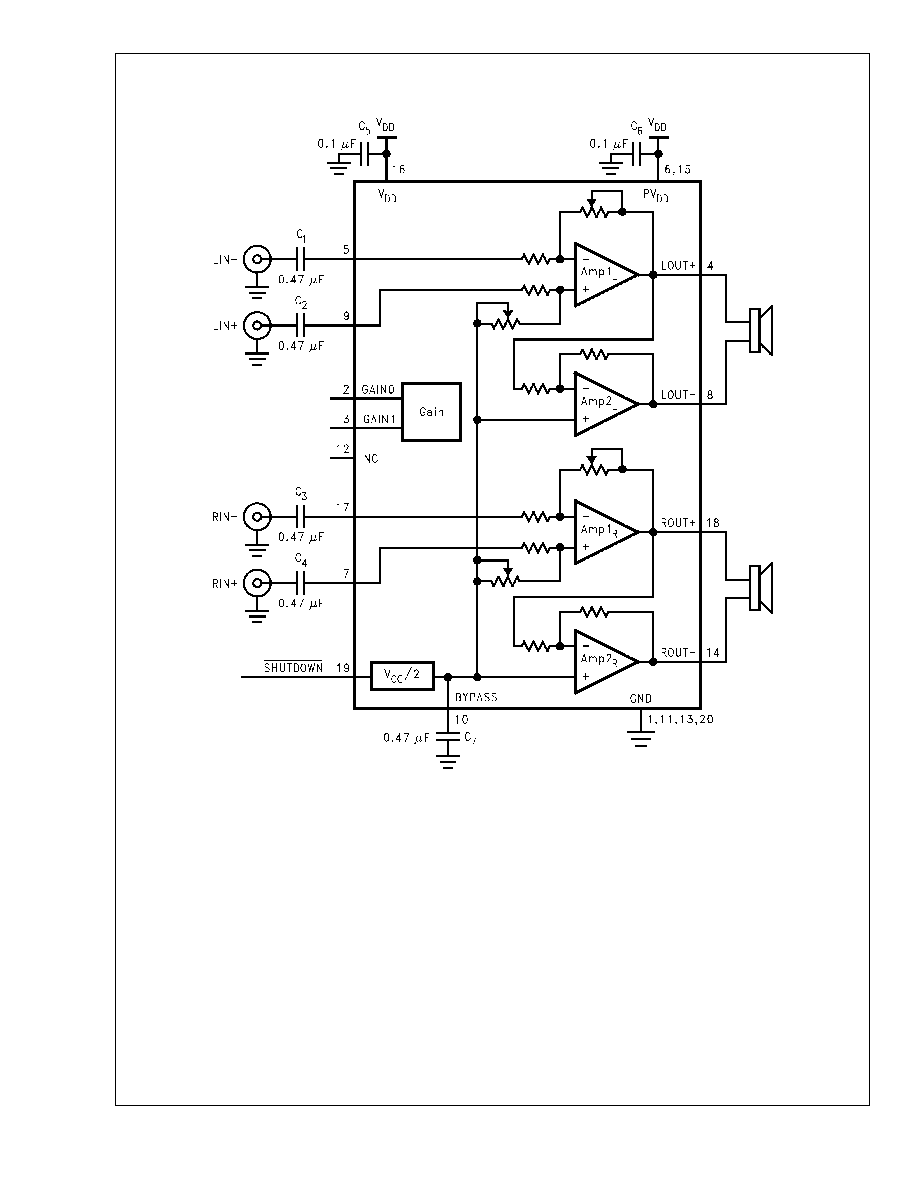
LM4869
1.9W Differential Input, BTL Output Stereo Audio
Amplifier with Selectable Gain and Shutdown
General Description
The LM4869 features differential stereo inputs, BTL (bridge-
tied load) outputs, and four externally selectable fixed gains.
Operating on a single 5V supply, the LM4869 delivers 1.2W
and 1.9W (typ) of output power to an 8
and 4 BTL load
(Note 1), respectively, with less than 1% THD+N. The
LM4869's gain is selected using two digital inputs. The nomi-
nal gain values are 6dB, 10dB, 15.6dB, and 21.6dB.
The LM4869 is designed for notebook and other handheld
portable applications. It delivers high quality output power
from a surface-mount package and requires few external
components.
Other features include an active-low micropower shutdown
mode input and thermal shutdown protection.
Key Specifications
j
BTL output Power
R
L
= 4
, V
DD
= 5.0V, and THD+N = 1%
1.9W (typ)
j
BTL output Power
R
L
= 8
, V
DD
= 5.0V, and THD+N = 1%
1.2W (typ)
j
Micropower shutdown current
0.1�A (typ)
j
PSRR (
@
1kHz, V
DD
= 5V, (Fig.1))
62dB (typ)
Features
n
Fully differential input and output
n
Internal gain set: 6dB, 10dB, 15.6dB, and 21.6dB
n
Improved 'click and pop' suppression
n
Thermal shutdown protection circuit
n
Ultra low current micropower shutdown mode
n
2.0V to 5.5V operation
n
Available in space-saving exposed-DAP TSSOP
package
Applications
n
Notebook computers
n
PDAs
n
Portable electronic devices
Connection Diagram
Top View
20042802
Order Number LM4869MH
See NS Package Number MXA20A for Exposed-DAP TSSOP
Boomer
�
is a registered trademark of National Semiconductor Corporation.
August 2002
LM4869
1.9W
Differential
Input,
BTL
Output
Stereo
Audio
Amplifier
with
Selectable
Gain
and
Shutdown
� 2002 National Semiconductor Corporation
DS200428
www.national.com

Absolute Maximum Ratings
(Notes 2,
3)
If Military/Aerospace specified devices are required,
please contact the National Semiconductor Sales Office/
Distributors for availability and specifications.
Supply Voltage
6.0V
Storage Temperature
-65�C to + 150�C
Input Voltage
-0.3V to V
DD
+ 0.3V
Power Dissipation (Note 4)
Internally Limited
ESD Susceptibility (Note 5)
2000V
ESD Susceptibility (Note 6)
200V
Junction Temperature
150�C
Soldering Information
Small Outline Package
Vapor Phase (60 sec.)
215�C
Infrared (15 sec.)
220�C
See AN-450 "Surface Mounting and their Effects on
Product Reliability" for other methods of soldering surface
mount devices.
Thermal Resistance
JC
(typ) MXA20A
2�C/W
JA
(typ) MXA20A
47�C/W (Note 7)
JA
(typ) MXA20A
27�C/W (Note 8)
Operating Ratings
Temperature Range
T
MIN
T
A
T
MAX
-40�C
TA 85�C
Supply Voltage
2.0 V
V
DD
5.5V
Electrical Characteristics for LM4869
(Notes 2, 9)
The following specifications applies to the LM4869 when used in the circuit shown in Figure 1 and operating with V
DD
= 5V and
A
V
= 6dB, unless otherwise specified. Limits apply for T
A
= 25�C.
Symbol
Parameter
Conditions
LM4869
Units
(Limits)
Typical
(Note 9)
Limit
(Note 10)
(Note 11)
V
DD
Supply Voltage
2
5.5
V (min)
V (max)
I
DD
Quiescent Power Supply Current
V
IN
= 0V, I
O
= 0A, R
L
=
9.0
12.0
mA (max)
I
SD
Shutdown Current
V
shutdown
= GND
0.1
1.0
�A (max)
V
OS
Output Offset Voltage
7
50
mV (max)
PSRR
Output Supply Rejection Ratio
V
DD
= 5V, V
RIPPLE
= 200mV
P-P
sinewave, C
BYPASS
= 0.47�F,
R
L
= 8
62
dB
P
O
Output Power (Note 12)
THD+N = 1% (max), f = 1kHz (Note13)
R
L
= 4
R
L
= 8
1.9
1.2
1.0
W
W (min)
THD+N = 10% (max), f = 1kHz
(Note13)
R
L
= 4
R
L
= 8
2.6
1.5
W
W
THD+N
Total Harmonic Distortion + Noise
20Hz
f 20kHz
R
L
= 4
, P
O
= 2W
R
L
= 8
, P
O
= 1W
0.3
0.3
%
%
S/N
Signal-to-Noise Ratio
f = 1kHz, C
BYPASS
= 0.47�F,
P
O
= 1.1W, R
L
= 8
97
dB
R
IN
Input Resistance
Pins 5, 7, 9, and 17
25
20
k
(min)
A
V
Gain Accuracy
R
L
= 8
Logic Low Applied to Pin 2
Logic Low Applied to Pin 3
6
5.70
6.30
dB (min)
dB (max)
Logic Low Applied to Pin 2
Logic High Applied to Pin 3
10
9.65
10.35
dB (min)
dB (max)
Logic High Applied to Pin 2
Logic Low Applied to Pin 3
15.6
15.25
15.95
dB (min)
dB (max)
Logic High Applied to Pin 2
Logic High Applied to Pin 3
21.6
21.25
21.95
dB (min)
dB (max)
LM4869
www.national.com
3

Electrical Characteristics for LM4869
(Notes 2, 9) (Continued)
The following specifications applies to the LM4869 when used in the circuit shown in Figure 1 and operating with V
DD
= 5V and
A
V
= 6dB, unless otherwise specified. Limits apply for T
A
= 25�C.
Symbol
Parameter
Conditions
LM4869
Units
(Limits)
Typical
(Note 9)
Limit
(Note 10)
(Note 11)
A
V CH-CH
Channel-to-Channel Gain Mismatch
R
L
= 8
Logic Low Applied to Pin 2
Logic Low Applied to Pin 3
0.12
0.3
dB (max)
Logic Low Applied to Pin 2
Logic High Applied to Pin 3
0.12
0.3
dB (max)
Logic High Applied to Pin 2
Logic Low Applied to Pin 3
0.12
0.3
dB (max)
Logic High Applied to Pin 2
Logic High Applied to Pin 3
0.12
0.3
dB (max)
Note 1: An LM4869MH that has been properly mounted to a circuit board with a copper heatsink area of at least 2in
2
will deliver 1.9W into 4
.
Note 2: All voltages are measured with respect to the GND pin unless other wise specified.
Note 3: Absolute Maximum Ratings indicate limits beyond which damage to the device may occur. Operating Ratings indicate conditions for which the device is
functional but do not guarantee specific performance limits. Electrical Characteristics state DC and AC electrical specifications under particular test conditions that
guarantee specific performance limits. This assumes that the device is within the Operating Ratings. Specifications are not guaranteed for parameters where no limit
is given, however, the typical value is a good indication of device performance.
Note 4: The maximum power dissipation must be derated at elevated temperatures and is dictated by TJMAX,
JA
, and the ambient temperature, T
A
. The maximum
allowable power dissipation is P
DMAX
= (T
JMAX
- T
A
/
JA
or the number given in Absolute Maximum Ratings, whichever is lower. For the LM4869, see power derating
currents for more information.
Note 5: Human body model, 100 pF discharged through a 1.5 k
resistor.
Note 6: Machine Model, 220pF-240pF discharged through all pins.
Note 7: The given
JA
is for an LM4869 packaged in an MXA20A with the exposed-DAP soldered to an exposed 4in
2
area of 1oz printed circuit board copper. When
driving 4
loads from a 5V supply, the LM4869MH must be mounted to the circuit board and its exposed-DAP soldered to an exposed 2in
2
area of 1oz PCB copper.
Note 8: The given
JA
is for an LM4869 packaged in an MXA20A with the exposed DAP soldered to an exposed 8in
2
area of 1oz printed circuit board (PCB) copper
and two 8in
2
inner layer ground planes in a four-layer PCB.
Note 9: Typicals are measured at 25�C and represent the parametric norm.
Note 10: Limits are guaranteed to National's AOQL (Average Outgoing Quality Level).
Note 11: Datasheet minimum and maximum specification limits are guaranteed by design, test, or statistical analysis.
Note 12: Output power is measured at the amplifier's package pins.
Note 13: When driving 4
loads and operating on a 5V supply, the LM4869MH must be mounted to a circuit board that has a minimum of 2.5in
2
of exposed,
uninterrupted copper area connected to the LLP package's exposed DAP.
External Components Description
( Refer to Figure 1.)
Components
Functional Description
1.
C
i
The input coupling capacitor blocks DC voltage at the amplifier's inverting input terminals. C
i
, along with the
LM4869's fixed input resistance R
i
(25k
, typ), creates a highpass filter with f
C
= 1/(2
R
i
C
i
). Both inverting
and noninverting inputs require a C
i
. Refer to the Application Information section, SELECTING EXTERNAL
COMPONENTS, for an explanation of determining the value of C
i
.
2.
C
S
The supply bypass capacitor. Refer to the POWER SUPPLY BYPASSING section for information about
properly placing, and selecting the value of, this capacitor.
3.
C
B
The capacitor, C
B
, filters the half-supply voltage present on the BYPASS pin. Refer to the Application
Information section, SELECTING EXTERNAL COMPONENTS, for information concerning proper placement
and selecting C
B
's value.
LM4869
www.national.com
4




